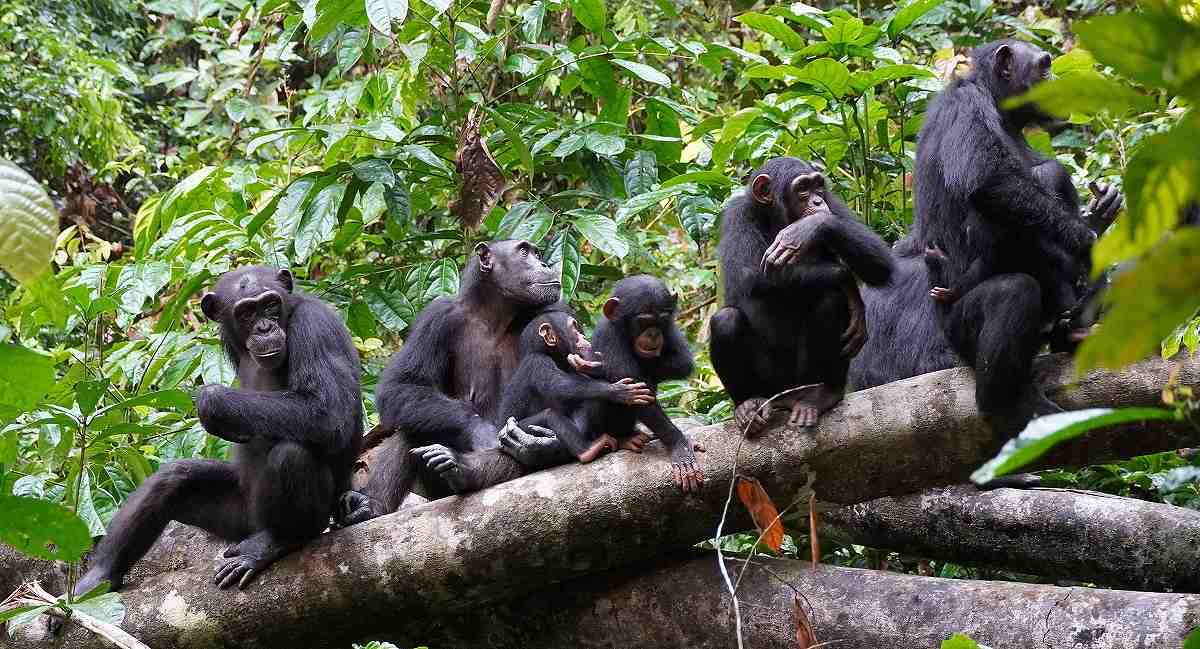
A group of chimpanzees listen to other chimpanzees heard at a distance in the West African forests of Cote d’Ivoire in this undated handout photograph.
15:33 JST, November 17, 2023
On the boundary of dangerous territory, a troop of about 30 individuals engaging in a border patrol climbs a rocky hill to conduct reconnaissance. Detecting the sounds of adversaries a bit too close for comfort, the squad retreats. There is no reason to risk a fight with the odds against you.
It is a scenario that has unfolded innumerable times in the history of human warfare. But in this case, it involved not people but chimpanzees in Tai National Park in southwestern Cote d’Ivoire, West Africa’s largest protected area of rainforest.
Researchers said on Nov. 2 they have documented the tactical use of elevated terrain in warfare situations while observing on a daily basis two neighboring communities of wild western chimpanzees in Tai National Park for three years.
Information obtained during hilltop reconnaissance shaped whether the chimpanzees made forays into enemy territory, the study found, with these apes appearing more apt to do so when the risk of confrontation was lower. The study, the researchers said, records for the first time the use of this age-old human military strategy by our species’ closest living relatives.
“It shows sophisticated cognitive and cooperative skills to anticipate where and when to go, and to act upon gathered information in a safe way,” said University of Cambridge biological anthropologist Sylvain Lemoine, lead author of the study published in the journal PLOS Biology.
Inter-group violence is ubiquitous in chimpanzees, Lemoine said. Skirmishes occasionally occur in overlapping border areas.
“Chimpanzees compete for space, which encompasses food resources. Large territories are beneficial as it reduces within-group competition, and female reproductive rates are increased in larger territories,” Lemoine said.
The two neighboring groups tracked in this study were of equivalent size, between 40 and 45 individuals, with about five to six adult males and 10 to 13 adult females, the rest being adolescents, juveniles and infants. Males are always dominant over females, the researchers said.
“Chimpanzees are extremely territorial. They undertake regular border patrols, where individuals roam in the periphery of their territory in a very coordinated and cohesive way,” Lemoine said.
“They engage in inter-group encounters that are violent, dangerous and stressful. Inter-group encounters can be vocal exchanges from a distance, visual contacts or physical contacts with fights, bites and chases. Killings are common, and victims can be from all age classes,” Lemoine added.
Climbing hills does not necessarily improve visual detection of members of a rival community, instead offering improved acoustic conditions to detect adversaries by sound.
“The tops of hill are covered in vegetation and do not offer good lookout points,” Lemoine said.
While atop border hills, the chimpanzees typically refrained from noisily eating or foraging, instead resting and listening.
They were more likely to advance into dangerous territory after descending a hill if the rival chimpanzees were further away. Such incursions occurred approximately 40% of the time when rivals were about 500 meters away, 50% when rivals were about 1 kilometer away and 60% when rivals were about 3 kilometers away.
Chimpanzees and the closely related bonobos are the species nearest genetically to humans, sharing about 98.8% of our DNA. The human and chimpanzee evolutionary lineages split about 6.9 million to 9 million years ago, according to research published in June.
Studying chimpanzee behavior may offer insight into our own species.
“We can better understand where we come from and what makes us human. We can better understand which kind of behaviors and adaptations were present in the last common ancestor between humans and chimpanzees, and have a better idea of the sociality and behavior of ancient hominin species,” Lemoine said, referring to extinct species on the human lineage.
“It also teaches us what we have in common with our closest living relatives, how similar we are with wild animals, and that we only differ from our cousins in degree and not in nature,” Lemoine added.
"Science & Nature" POPULAR ARTICLE
-

Genome Study Reveals Milestone in History of Cat Domestication
-

Big Leap in Quest to Get to Bottom of Climate Ice Mystery
-

Security Camera Footage Vulnerable to Outside Access; Investigation Finds 3,000 Pieces Exposed Online
-

Paws on Parade: Nairobi’s Dogs Dazzle at ‘Pawchella’
-

Japan Set to Participate in EU’s R&D Framework, Aims to Boost Cooperation in Tech, Energy
JN ACCESS RANKING
-

Keidanren Chairman Yoshinobu Tsutsui Visits Kashiwazaki-Kariwa Nuclear Power Plant; Inspects New Emergency Safety System
-

Imports of Rare Earths from China Facing Delays, May Be Caused by Deterioration of Japan-China Relations
-

University of Tokyo Professor Discusses Japanese Economic Security in Interview Ahead of Forum
-

Tokyo Economic Security Forum to Hold Inaugural Meeting Amid Tense Global Environment
-

Japan Pulls out of Vietnam Nuclear Project, Complicating Hanoi’s Power Plans
























